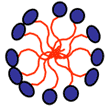
Dishwashing (or washing up, depending on your location), while a calming and meditative time for some, is not everybody’s idea of fun. But fortunately it offers two factors which should appeal to any geeks: science and logic.
Whether you’ve been taught by a kindly relative, discovered it from trial and error, or resorted to a Google search, you likely know that washing dishes effectively requires hot soapy water. But why is this, and why does cold or clear water not do the trick as well?
The key to the soapiness in this situation is that you are not usually tackling dirt (as with laundry) but specifically oils and grease. Most of the active components of dishwashing detergent (also known as washing up liquid) are surfactants, a contraction of “surface active agent”. Put simply, these are made of molecules which have a hydrophilic head, meaning it is attracted to water, and a lipophilic tail, meaning it is attracted to grease and oil.
 These molecules then form into tiny balls known as micelles (pictured right) in which the hydrophilic heads form the surface of the ball. As the micelles form, come apart, and then reform, the lipophilic tails grab on to the grease and separate it from the surface of the item being washed. This makes it much easier to then remove the grease from the item with a dish brush.
These molecules then form into tiny balls known as micelles (pictured right) in which the hydrophilic heads form the surface of the ball. As the micelles form, come apart, and then reform, the lipophilic tails grab on to the grease and separate it from the surface of the item being washed. This makes it much easier to then remove the grease from the item with a dish brush.
Why hot water? It’s partly because some of the components of detergent are more soluble at hotter temperatures, and partly because the heat helps melt some of the fats and grease. (Of course, hot water also has other benefits such as being more likely to kill any bacteria and meaning your crockery and cutlery will dry quicker.)
With the science taken care of, the next step is the order in which to do the dishes. While you could just do them in whatever order you can reach them, the true geek way is to find the method which cuts down time and motion, while maximizing the results as you go, and ideally using the minimum amount of water that does the trick. The key is to remember that the water will naturally get dirtier as you clean, which affects its ability to clean items as you go on — but the point at which this becomes a problem depends on exactly what you are cleaning.
Your mileage may vary, but my assessment is that the most efficient method is to begin by scraping off any large remnants of food from all your cutlery and crockery, then filling any particularly greasy pans with hot water to soak. Then, rather than muddle through, start by arranging the things to be washed into piles, arranged in this order of proximity to the sink:
• glass
• cutlery
• cooking utensils (wooden spoons, ladles, etc)
• crockery
• other ceramics
• plastics
• metals
Then add some detergent to the washing up bowl and a couple of inches of hot water, sloshing the bowl about as you do to create a lather. (Whether you scientifically need the lather appears debatable, but it does create a useful visual guide to how much detergent is left in the water.) If you have particularly delicate glass, you may want to start with warm rather than piping hot water.
For each pile, wash it and add it to an upside down pile besides the sink. When the whole pile is done, turn on the hot tap again and pass each item under the tap to rinse it before placing it in a right-way-up pile on the other side of the sink. Stop the tap when you’re done and then wipe each item (or put them on a drying rack, depending on your preferences.) Then move on to the next step.
Using this method means that you don’t waste any water while rinsing as it’s all collected in the bowl. You’ll note the depth of the water increases quite neatly in line with the items being washed getting bigger. You should also find that the items you wash later are more resistant to becoming streaked by any greasiness that has built up in the water. However, you should still replace the water completely if it either starts to feel tepid or if the bubbles have disappeared completely.
Of course, that’s just my take. If you’ve spotted a flaw in the science, or think you’ve got a more efficient way of doing things, please do let us know in the comments section.
[Illustration courtesy of Flickr user lsgcp]
